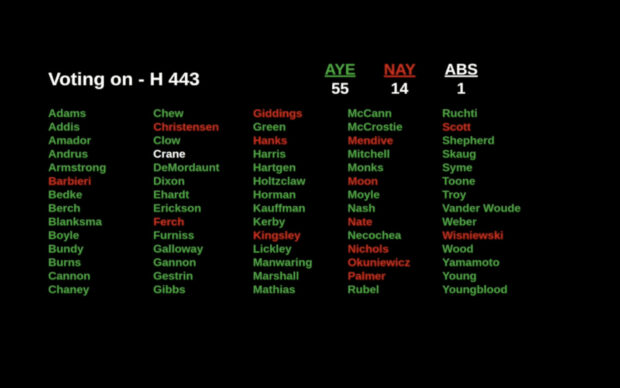The Idaho House on Monday passed a bill designed to boost funding for health insurance for K-12 administrators, teachers and classified staffers.
The bill would set up a fund to hold added money for school districts to use on health insurance. The goal is to enable districts to use the state’s plan, which charges lower premiums and out-of-pocket costs to employees. Districts would have the option of joining the state plan, or choosing another insurance carrier.
Sponsors suggested the temporary fund hold around $75.5 million, to cover the upfront cost of switching to the state plan. The bill would also fulfill another of Gov. Brad Little’s requests: phasing out leadership premiums for teachers. Little wants to shift this $17.9 million a year toward the $105 million-a-year ongoing cost of improved insurance.
The bill’s sponsor, Rep. Rod Furniss, R-Rigby, called the plan “a good tradeoff for better health insurance.”
Overwhelmingly positive testimony matched a 55-14 supportive vote. At least a half dozen current and former school district employees from both sides of the aisle spoke loftily of the proposal.

Retired superintendent Rep. Ryan Kerby, R- New Plymouth, called it a “once-in-a-generation” opportunity, pointing to a longstanding gulf between the $8,500 school employees get on average to fund their health insurance and the $12,500 other state employees receive.
Recalling her start in teaching in the 1970s, Gooding Democratic Rep. Sally Toone said her family “really didn’t have health insurance” because of her four-figure salary and expensive health insurance.
Others, including Rep. Ron Nate, R-Rexburg, and Rep. Heather Scott, R-Blanchard, said they backed getting more employees on the state plan but opposed doing so when the benefit would solely be reaped by Blue Cross of Idaho, which previously won a bid to serve as the state’s provider.
That gives Blue Cross “the first bite of the apple” and “monopoly power” until the state’s contract comes up for another bid next year, Nate argued.
Countered Furniss, “We’re not creating a monopoly. We’re not creating an additional market share.”
A total of 85% of Idaho schools that have insurance already use Blue Cross, Furniss said.
The bill would still have to pass through the Senate, both in committee and on the floor. Then, the Joint Finance-Appropriations Committee would have to approve putting $75.5 million into the fund, and both the House and Senate would have to approve that spending bill.
Bill cosponsor and JFAC member Rep. Wendy Horman, R-Idaho Falls, said it’s her intention that JFAC will earmark the money all for staff health insurance; the bill passed Monday doesn’t take that step. JFAC is still in the early stages of budget writing, so a move to fill the proposed fund would come later.
A tuition increase is likely this year
Idaho’s four-year schools will probably have to increase tuition next year — in order to cover employee raises, limit staff turnover and compete with the private sector.
State Board of Education President Kurt Liebich made this prediction Monday, as he spoke to the Legislature’s Joint Finance-Appropriations Committee.

Liebich didn’t provide details on the size of a potential tuition hike.
“We have not done the work that is necessary to make a determination on that,” he said.
“We certainly need to understand the inflation pressure that’s on our institutions.”
Boise State University, the University of Idaho, Idaho State University and Lewis-Clark State College have held the line on tuition for the past two years. The freeze has held in-state, undergraduate tuition at anywhere from $6,982 at Lewis-Clark to $8,340 at the U of I.
Instituted just months before the global pandemic, the freeze was designed to encourage more Idaho students to attend college. And most schools have also held the line on tuition for out-of-state students — an enrollment growth area this year.
But at the same time, Liebich said, Idaho’s four-year schools are dealing with staff turnover: 17% to 20% among classified employees; 11% to 21% among professional employees; and 8% to 10% in its faculty ranks.
Pay raises could help colleges and universities compete in a tight labor market. But there’s a catch. While Gov. Brad Little has proposed a 5% boost in state employee pay, the state doesn’t fully fund raises on campuses. Colleges and universities would have to come up with about half of the money needed to cover a 5% raise.
Legislators don’t have a direct say over tuition. Ultimately, that’s the State Board’s call.
But legislators do decide how much state money to give to Idaho’s four-year and two-year schools, and that work is beginning in JFAC this week. College and university presidents will make budget pitches from Tuesday through Friday. (Check back at Idaho Education News daily for updates.)
Little has proposed a 7.1% increase for the four-year schools — or $22.3 million, which is likely the largest one-year dollar increase for higher ed in state history.
The community colleges would receive a 4.8% increase, or nearly $2.5 million.
Other Liebich talking points
During his wide-ranging remarks Monday, Liebich unveiled a new State Board study — and got some pushback from one JFAC hardliner.
A $4.5 billion impact. On Monday, the State Board released a new study on higher education’s economic impact. Among the highlights: The eight schools generate $4.5 billion, slightly more than 5% of the state’s gross state product. The colleges and universities provide more than 85,000 jobs statewide — between on-campus jobs and jobs supported by higher ed.
Resetting the narrative. Liebich said the state’s education system is “punching above its weight,” given per-pupil spending that ranks lowest in the nation. But he said the state needs to take back the education narrative from political hardliners who want to defund the school system. “I don’t understand this vocal minority’s stated goal or intent,” Liebich said. “The fact is we have a strong system, and it is the backbone of our booming economy.”
Academic loss and test scores. Early test results are encouraging, Liebich said, because they suggest Idaho’s pandemic learning loss isn’t as widespread as feared. But he conceded the state has room for improvement across the board — in early literacy, standardized test scores and college go-on and graduation rates.
Rep. Ron Nate, R-Rexburg, decried the state’s static numbers. “We’ve been dumping more and more money into the education system with little to no results.”
“Chasing ghosts.” Nate and Liebich had a tense exchange over critical race theory and school indoctrination.
Saying parents are frustrated as they see “more and more wokeness” in their kids’ schools, Nate said the State Board has had a hand in pushing the principles of critical race theory. In particular, Nate decried a proposed State Board policy on diversity, equity and inclusion.
At one point, JFAC co-chair Rick Youngblood, R-Nampa, told Nate to drop his line of questioning.
Liebich answered anyway. He pointed out the State Board surveyed college students last fall, and across the political spectrum, the vast majority of the 9,000 respondents said they feel comfortable sharing their views on campus. The proposed board policy is simply an attempt to define diversity, equity and inclusion, he said, “so we’re not running around the state chasing ghosts.”
